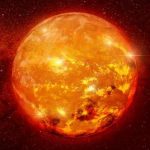 History
History  History
History  Weird Stuff
Weird Stuff 10 Superstitious Beliefs That Once Consumed Entire Cultures
 History
History 10 Bizarre Friendly Fire Incidents in Military History
 Technology
Technology 10 Modern Technologies That Accidentally Imitate Ancient Magic
 Mysteries
Mysteries 10 Mysteries of the Human Genome
 Weird Stuff
Weird Stuff 10 Things So Rare They’ve Only Been Found Once
 History
History 10 Legends Whose Last Moments Undid Their Glory
 Health
Health 10 Futuristic Ideas to Treat Common Medical Problems
 Weird Stuff
Weird Stuff Ten Surreal Attempts to Reverse Baldness
 Facts
Facts 10 U.S. Government Contingency Plans for the Unthinkable
 History
History 10 Odd Things Colonial Americans Kept at Home
 Weird Stuff
Weird Stuff 10 Superstitious Beliefs That Once Consumed Entire Cultures
 History
History 10 Bizarre Friendly Fire Incidents in Military History
Who's Behind Listverse?

Jamie Frater
Head Editor
Jamie founded Listverse due to an insatiable desire to share fascinating, obscure, and bizarre facts. He has been a guest speaker on numerous national radio and television stations and is a five time published author.
More About Us Technology
Technology 10 Modern Technologies That Accidentally Imitate Ancient Magic
 Mysteries
Mysteries 10 Mysteries of the Human Genome
 Weird Stuff
Weird Stuff 10 Things So Rare They’ve Only Been Found Once
 History
History 10 Legends Whose Last Moments Undid Their Glory
 Health
Health 10 Futuristic Ideas to Treat Common Medical Problems
 Weird Stuff
Weird Stuff Ten Surreal Attempts to Reverse Baldness
 Facts
Facts 10 U.S. Government Contingency Plans for the Unthinkable
10 Incredible Scenes of Cosmic Violence
The universe is full of awe-inspiring sights like colorful nebulae, giant planets of swirling gas, and brilliant stars that shine like gems. The universe is also full of chaos and violence, with constant destruction (and rebirth) keeping the cosmos in an eternal flux. The following discoveries are awe-inspiring for their sheer power, destructive majesty, and awesome explosions.
Related: Top 10 Bizarre And Deadly Exoplanets
10 “Death Star Black Holes”
Black holes aren’t just destructive by literally turning things into spaghetti with their insane gravity. Some black holes are also like Death Stars on steroids, firing intense beams of super-fast particles across the universe. These black holes may also swivel, sometimes by 90 degrees, to fire their beams in various directions—because who’s going to stop them?
This may occur on incredibly short cosmic time scales of just one or a few million years. That’s chump change compared to the ages of the observed black holes, which are likely to be more than 10 billion years old.
For perspective, the researchers liken it to changing the course of a battleship in a few minutes. For astronomical consequences, these beams dump massive amounts of energy into the gas clouds in their galaxy, preventing new stars from forming because star formation requires cold gas to accumulate.[1]
9 Dead Stars Eating Their Planets
White dwarfs are dead stars that were once as massive as the Sun. In their death throes, they lost their outer layers and left behind a small, dense, cooling cinder. This may also mean the demise of any planets too close to their parent stars.
Our galaxy is full of these corpses, slowly cooling departed stars whose bodies are littered with the broken remnants of their torn-apart planets. Timescales are nearly impossible to comprehend: The annoyingly named dead star WDJ2147-4035 is 10.7 billion years old and has been dead for over 10 billion years. Its atmosphere is littered with debris from its formerly healthy planet.
Another white dwarf, called WDJ1922+0233, is slightly younger and “polluted” by pieces of its destroyed planet’s crust, similar to Earth in composition.
As the researchers say, it’s mind-bending to think that these systems have been dead and destroyed long before our Earth (and solar system) was born. Earth’s fate may be similar in 4-or-5-ish billion years.[2]
8 A Disintegrating Planet Spilling Its “Guts”
It’s one thing to find long-dead planets and another to observe a planet in the process of its demise. Fortunately, better technology and refined observation methods have given us many first-time-ever discoveries.
This recently includes the first glimpse at an exoplanet’s spilled “guts.” The planet is called K2 22b. It’s Neptune-sized and really close to its star, making an orbit in just 8 hours.
It’s also only visible by the cloudy trail it leaves in its wake, which blocks out the light from its parent star. Scientists say this cloud could be made of solidified magma, the planet’s own “entrails,” as the icy body is melting. The researchers liken it to a “snowball disintegrating,” except, you know, on a Neptune-sized scale.[3]
7 Plasma Rain “Fireballs” on the Sun
It rains on the Sun. When things evaporate, they generally float upward. Once they get high enough and cool down, they condense and fall back as “rain.” Therefore, it can rain in unexpected places, like our Sun. Of course, the rain on the Sun is made of plasma, but that’s not news. What is news is that NASA’s Solar Orbiter has captured “fireballs” created by the violently plunging solar rain.
Plasma is an insanely hot material, so hot that it splits at the atomic level and becomes electrically charged. As solar rain plummets back down, it smacks into the chromosphere, a layer made of plasma. The resultant high-energy, plasma-on-plasma violence causes a fireball effect, similar to what we see in the sky when a meteor smashes through our atmosphere.[4]
6 Zombie Stars with Crushing Diamond Atmospheres
Few things are stronger than neutron stars, the spinning carcasses of stars that are several to multiple times the mass of our Sun. When these stars blow up, they can leave behind remnants like Cassiopeia A, which is about 14 miles (22.5 km) wide yet more massive than the Sun.
So it’s no wonder that a mind-bending crush is occurring: the gravity at the surface is “100 billion times stronger than on Earth.” As a result, a neutron star’s exotic atmosphere is made of carbon that’s getting squashed by almost unimaginable pressures 10 times greater than what would be experienced inside Earth’s core. As a result of this gravitational violence, the neutron star’s atmosphere is being crushed to a density similar to diamonds.[5]
5 Some Stars Explode Multiple Times
Lots, maybe most, stars come in pairs. Needless to say, having two gigantic nuclear bombs spinning around each other leads to some intriguingly violent scenarios. Especially when one of them dies.
While some stars blow up, other stars blow up many times. The one featured here is the core of a dead star. This core, a white dwarf, has another star orbiting around it. But the white dwarf is massive enough to siphon the gas from its companion star, causing the dwarf to eventually explode once it reaches a certain threshold of mass. And explode it does… every single year!
The exploding body gets millions of times brighter and throws material out at thousands of miles per second. No one-trick-pony, this celestial body has been blowing up regularly for millions of years, creating a giant shell of debris 400 light-years wide.[6]
4 A Galaxy with Beams 32 Times Bigger Than Our Galaxy
Giant Radio Galaxies (GRGs) have a signature feature: gigantic death beams blasting from their poles. Death beam may be a bit unscientific, but these are jets of scorching plasma that stretch for millions of light-years throughout intergalactic space—think of GRGs as galaxy-sized Death Stars.
The newly described monster is named Inkathazo, meaning “trouble” in the Xhosa and Zulu languages. Its plasma jets are 32 times the size of our Milky Way. Like its name, its existence is somewhat troubling to people who describe the existence of insane objects in space. Its jets are kind of wonky, with one of them bent, and the whole thing lives in a cluster of galaxies instead of in isolation.
And what causes the cosmic mayhem of a GRG? Black holes. When they suck up matter too quickly, they can’t gulp it all down. As a result, much of it gets shot out at incredible temperatures and relativistic speeds, blasting from the poles of the feeding black hole.[7]
3 A Molten Earth-Sized Planet
Some planets make us appreciate our blue-green marble more than ever, as per NASA’s recent description of an Earth-sized planet with a “lava hemisphere.” Basically, half the planet is a molten inferno.
Peeping at the HD 63433 star system revealed an intriguing object, a small planet. The star is Sun-like, and the planet is called HD 63433 d. It’s tidally locked, so it always has a day side and a night side. In addition to its hellish hemisphere, it’s notable as the “smallest confirmed exoplanet younger than 500 million years old.” It’s the closest, Earth-like planet to be so young, approximately 400 million years old, or more than 10 times younger than our middle-aged Earth.
Since tidally locked things are close to their parent, this Earth-sized rock (1.1 times the diameter of our planet) is so close that its year is only 4.2 days long. That’s 8 times closer than Mercury is to the Sun, yielding a day-side surface temperature of around 2,300 degrees Fahrenheit.[8]
2 An Infant Star Being Violently Born
Stars aren’t just violent when they die, but when they’re born as well. Birthing stars also release lots of energy and flares of deadly radiation, kind of like mini-supernovae. Recently, Hubble captured a brilliant stellar triumvirate nestled within the hollows of a nebula.
HP Tau is noteworthy because it’s a T Tauri star, like an infant Sun. Potentially younger than 10 million years, HP Tau is such a baby that it hasn’t yet begun nuclear fusion. It is still very early in an evolutionary phase that will see it become similar to the Sun.
It displays random brightness fluctuations due to still being “swaddled” in its gassy shroud of creation. The star releases chaotic flares as it gobbles in-falling material from its accretion disk, creating energetic clashes as it falls onto the growing star at cosmic speeds.[9]
1 A Planet with 20,000 MPH Winds
The universe really destroys our perception of wind speed. On Earth, even 30 mph (48.3 km/h) wind gusts are a major inconvenience and detriment to fences, trees, and wheeled garbage cans. At 70+ mph (112.6+ km/h), we enter hurricane territory.
Yet scientists have just described the fastest wind speed yet measured in the cosmos: 20,000 mph (32,186 km/h) on an exoplanet named WASP-127b. It’s about 520 light-years away and one-third larger than Jupiter. Yet it’s only 16% Jupiter’s mass, making it also one of the puffiest planets ever discovered. There’s no solid surface, just clouds and wind, which whips around the planet’s equator at 20,500 mph, or about 80 times faster than Earth’s most intense wind gust.[10]








